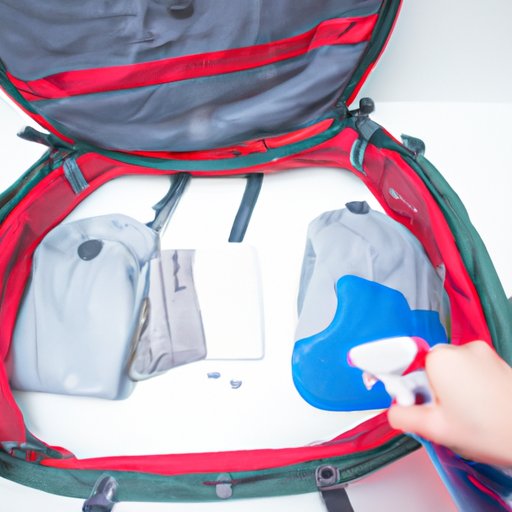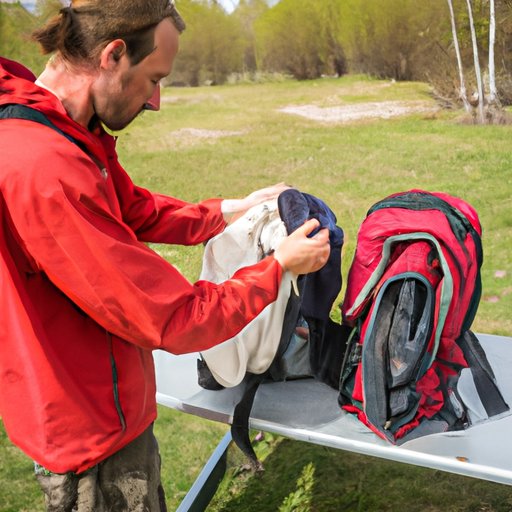
Introduction
Backpacks are versatile and essential accessories for many people, being used for school, work, travel, and outdoor activities. Over time, backpacks become dirty and accumulate microbes, sweat, dust, or stains. Cleaning a backpack is essential not only for hygiene but also to prolong its lifespan. This article aims to provide a comprehensive guide on how to wash a backpack, covering hand washing and machine washing, addressing common mistakes, cleaning different types of fabrics, specialized products, and tips for maintaining and preserving a clean backpack.
Basics of Hand Washing a Backpack
Hand washing is a straightforward process but requires some preparation and care to avoid damaging the backpack. Before washing, always read the cleaning label and follow any instructions or recommendations from the manufacturer.
Preparing the backpack for washing:
Empty the backpack and remove any loose dirt, debris, or objects. Check all the pockets, zippers, and straps to ensure there are no small items or hidden dirt. If needed, use a brush or vacuum cleaner to remove the dust or crumbs.
Next, turn the backpack inside out to expose the lining and pockets. This step is essential for better cleaning and preventing any damage to the exterior of the backpack.
Step-by-step guide for hand washing a backpack:
1. Fill a basin or a bathtub with lukewarm water and add a mild detergent or a backpack cleaner.
2. Place the backpack inside the water, ensuring that it is fully submerged.
3. Gently scrub the backpack with a soft sponge or a cloth, starting from the bottom and working your way up to the straps and zippers.
4. Pay special attention to any stains or spots, and use a stain remover or vinegar solution if needed.
5. Rinse the backpack thoroughly with clean water until no soap residue remains.
6. Squeeze out the excess water, but do not wring or twist the backpack too hard, as this may damage the fabric or padding.
Tips for effective cleaning:
– Always use a mild detergent or a specialized backpack cleaner that is suitable for the specific type of fabric. Avoid using harsh chemicals, bleach, or fabric softener, as these may cause discoloration or damage.
– Do not scrub or rub too hard, especially on delicate or sensitive materials like leather, suede, or nylon.
– Use a soft sponge or a cloth, and avoid using a brush or an abrasive pad as they may scratch or tear the fabric.
– Do not let the backpack soak in the water for too long, as this may cause discoloration or damage to the design or the padding.
Benefits of Washing a Backpack
Cleaning a backpack has several benefits, including hygiene, preservation, and appearance.
Health benefits of keeping a clean backpack:
Backpacks can accumulate bacteria, germs, or fungi, especially if they are frequently exposed to sweat or other moisture sources. A dirty backpack can cause skin irritation, allergies, or even infections, posing a risk to the health and well-being of the user. By washing the backpack regularly, you remove the microbes and prevent their growth, promoting a healthier and safer environment.
Prolongs the life of the backpack:
A clean backpack lasts longer than a dirty one, as the accumulation of dirt, dust, or chemicals may weaken the fabric or the stitching. By washing the backpack, you remove the dirt and prevent future damage, prolonging the lifespan of the backpack and saving money in the long run.
Gives a fresh and clean appearance:
A clean backpack not only looks better but also reflects personal hygiene and care. A dirty or smelly backpack may give the impression of unprofessionalism or negligence, affecting the confidence and credibility of the user. By washing the backpack, you refresh its appearance and restore its original design, enhancing the overall look and feel.
Washing a Backpack in a Washing Machine
Machine washing is a convenient and efficient way of cleaning a backpack, but it requires some caution and preparation to avoid damaging the backpack or the machine.
When to use a washing machine:
Machine washing is suitable for backpacks made of durable fabrics, such as polyester, cotton, or canvas, and that do not have any delicate or sensitive components, such as leather, suede, or metallic zippers or buckles. Check the care label and follow any specific instructions, such as temperature, cycle, or weight limits.
Selecting the appropriate settings:
Use a gentle or delicate cycle, with cold or lukewarm water, and a mild detergent or a specialized backpack cleaner. Avoid using too much detergent, as it may cause excess suds and damage to the machine.
Precautions to avoid damaging the backpack:
Before machine washing, empty the backpack, remove any loose dirt or debris, and turn it inside out. Place the backpack inside a pillowcase or a laundry bag to protect it from the agitator or any other sharp edges.
After washing, do not put the backpack in the dryer, as the heat and friction may shrink or damage the fabric. Instead, hang the backpack or lay it flat on a towel in a well-ventilated area, away from direct sunlight or heat sources.
Addressing Common Mistakes
Washing a backpack may seem simple, but some common mistakes can lead to damage or unsatisfactory results.
Common mistakes to avoid when washing a backpack:
– Using hot water: Hot water may cause shrinking, fading, or discoloration of the backpack, especially for synthetic materials. Always use lukewarm or cold water.
– Skipping the preparation step: Preparing the backpack for washing is essential for better cleaning and preventing any damage to the design or the padding. Always empty the backpack, turn it inside out, and check the pockets and zippers for any hidden dirt.
– Using too much detergent: Using too much detergent may cause excess suds, which may damage the machine or the fabric. Follow the instructions on the detergent label or use a specialized backpack cleaner.
Tips for preventing damage to the backpack:
– Avoid using a dryer to dry the backpack, as the heat and friction may damage the fabric or the padding. Instead, hang the backpack or lay it flat in a well-ventilated area.
– Do not iron the backpack, as the heat may melt or deform the synthetic materials or any attachments.
– Avoid exposing the backpack to direct sunlight or heat sources, as this may cause fading or discoloration of the fabric or the design.
Corrective measures and troubleshooting:
– If the backpack has a strong odor, add a few drops of essential oils or vinegar to the washing water to neutralize the smell.
– If the backpack has tough stains or dirt, use a stain remover or a specialized cleaning product, following the instructions on the label.
– If the backpack has any defects or damages, such as torn straps, loose stitching, or broken zippers, repair them before washing or seek professional help if needed.
Cleaning Different Types of Backpack Fabrics
Each type of fabric requires special care and attention when washing, to avoid damage or discoloration.
Best practices for washing different types of backpack fabrics:
– Polyester: Machine wash with cold water and a gentle cycle, using a mild detergent or a specialized backpack cleaner. Avoid using fabric softener or bleach, as they may affect the color or the quality. Do not use a dryer and hang or lay flat to dry.
– Nylon: Hand wash with lukewarm water and a mild detergent, using a soft sponge or a cloth. Rinse thoroughly and air dry in a well-ventilated area, away from heat sources.
– Leather: Spot cleaning is recommended for leather backpacks, using a leather cleaner or a damp cloth. Avoid using water or any harsh chemicals that may cause damage or discoloration.
Techniques for removing tough stains:
– Ink: Use rubbing alcohol or hairspray to remove ink stains, by applying them on a cloth or a sponge and dabbing gently on the stain.
– Oil or grease: Use dish soap or laundry detergent to remove oil or grease stains, by applying a small amount on the stain and gently massaging it with a sponge or a cloth.
– Blood: Use cold water and a bit of salt to remove blood stains, by soaking the affected area for a few minutes and then rinsing with cold water.
Special considerations for delicate or sensitive fabrics:
– Silk: Hand wash with cold water and a gentle detergent, avoiding any twisting or rubbing. Gently squeeze out the excess water and air dry in a shaded area.
– Suede: Use a specialized suede cleaner and a soft brush to remove any dirt or stains, avoiding any harsh products or water.
– Canvas: Hand wash with cold water and a mild detergent, using a soft brush or a cloth, and avoiding any bleach or fabric softeners. Air dry in a well-ventilated area, away from heat sources.
Specialized Cleaning Products for Tough Stains and Odors
Some backpacks may have tough stains or persistent odors that require specialized cleaning products.
Overview of specialized cleaning products:
– Stain remover: A spray or a liquid that helps to remove tough stains, such as ink, grease, or blood, by breaking down the chemicals and lifting them from the fibers.
– Odor neutralizer: A spray or a powder that eliminates bad odors, such as sweat, mold, or smoke, by neutralizing the odor molecules and leaving a fresh scent.
– Backpack cleaner: A specialized product that is designed for backpacks, providing a deep and thorough cleaning, removing dirt, stains, and bacteria without damaging the fabric or the padding.
How to use specialized cleaning products:
– Follow the instructions on the label of each product, regarding the application, the dosage, and the safety precautions.
– Always test the product on a small and inconspicuous area of the backpack, before applying it on a larger or visible area.
– Wear gloves or protection if necessary, especially for harsh chemicals or strong scents.

Drying and Maintaining the Quality of the Backpack
Drying and preserving the backpack after washing is crucial to avoid damage or future dirt accumulation.
Tips for drying a backpack:
– Do not use a dryer, but instead hang the backpack or lay flat on a towel in a well-ventilated area, away from heat sources.
– Avoid direct sunlight or heat, as this may cause fading, discoloration, or melting of the fabric or the design.
– Do not hang the backpack by the straps, as this may cause stretching or tearing of the material.
How to preserve the quality of a backpack after washing:
– Store the backpack in a dry and clean place, away from any moisture or dust.
– Do not overload the backpack with heavy items or sharp objects, as this may cause damage or tear the fabric or the stitching.
– Use protection covers or cases to prevent any scratches or stains on the backpack, especially during travel or storage.
Maintaining the cleanliness of a backpack between washes:
– Shake off the loose dirt or debris periodically, especially after outdoor activities or travel.
– Clean any spills or stains as soon as possible, using a damp cloth or a specialized cleaning product.
– Spray a fabric freshener or an odor neutralizer on the back pack, to keep it smelling good and fresh.
Conclusion
Cleaning a backpack is a simple but essential task that can benefit your health, comfort, and budget. By following the steps and tips presented in this article, you can maintain a clean and hygienic backpack, prolong its lifespan, and enhance its appearance. Whether you choose to hand wash or machine wash, to use specialized products or to stick to mild detergents, always prioritize the care and protection of your backpack, and enjoy its usefulness and style for years to come.





